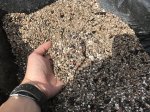Vance Wood
Lord Mugo
In New England as far in as upstate New York we get a lot of easterly storms year round, the humidity is too high, summers too short, and winters too harsh. Pine bark even composted never gets a chance to dry out or even decompose it goes straight to rot. As a result, even if you dont get root rot, the humid pine bark draws in Japanese Beetles which will then lay eggs in your pots just like in your lawn. Especially in your JM's as JM's are one of the Japanese Beetles favorite foods. I get that there is a lot of Mis-information on the web these days. But this information comes from over 10 years of growing bonsai and helping others across New England do the same. I've seen a lot of amazing trees die as a result of people using pine bark soil mixes up here, and although it can be done with A LOT of maintenance, it never ends well for the average grower.
Geeze, your conditions environmentally are pretty much like ours here in Michigan. You are the first person I have encountered on this site or any other that has had a problem with Japanese Beetles, I don't recall having a problem with any beetle of any description in my bonsai. I have been growing them, using composted Pine bark for probably more years than you have been alive, and I have not had a root rot problem that was my fault. People that lose a tree to root rot it is probably more to the break down of structure, and on thst argument I can give a thumbs down to Akadama which a lot of people praise as being able to raise the dead----- will in fact break down and turn to snot rather quickly. This can cause root rot a lot faster than composted Pine Bark. For growers that are thinking to make the argument against organic elements sometimes I am reminded that it sounds a lot like doctors trying to blame every condition in the medical books on smoking, from erectile dysfunction to pimples.
If you have people in your area that are losing trees to root rot I bet it is due to improper watering, or the break down of soil structure more than the use of Pine Bark in a soil mix. I've been doing this too long to believe anything else. By the time you get a tree and inspect it you most probably will find root rot but you still have not address the reason why the roots rotted, which is probably the same problem that caused the tree to suffocate and die in the first place. It's like finding a body in the woods that stinks and determining that it was decomposition that caused death. I was shown a member's tree earlier this year that was dead, The soil had insufficient drainage big time. Rot had no part in the problem that was discernible, other than entropy, the normal decomposition of dead items in a wet environment. You can do what you want to do, but don't think that this is the ending of all things. Think about it. When is the last time you went into a forest and found something growing in the kind of environment we are trying to create with all our inorganic elements.




